Molecular Cuisine has become a global brand, a reality that has led some to suggest that its time has passed: the sun has set on foam, night has made deconstruction invisible. As an avid diner, my suspicion is that some of the bubbly enthusiasm has waned, but this is not necessarily a bad thing for the cuisine. We are at the point where experiments are not done for their own sake, but because they actually taste good – they create memories on the palate.
In my attempt to collect stamps from all of the global molecular post offices, I knew that I would have to visit Bo Innovation on my trip to Hong Kong, presided over by “Demon Chef” Alvin Leung. In the 2009 Michelin Guide to Hong Kong, Bo Innovation received two stars, but in the 2010 guide was demoted to one (perhaps revealing the danger of palling around with Anthony Bourdain on “No Reservations” and god knows where else! How many bad boy chefs can one world take?).
But one star or two, Bo Innovation is a happening place, and eating at the kitchen “bar,” chatting with the cooks and servers, it reminded me of an Asian version of Washington’s Minibar. I give a lot of credit to AJ, the maitre d’, Mark, one of the servers, and Leah who was staging, for making my evening so congenial.
Bo Innovation’s ploy is a relatively simple one – clever and generally successful. Chef Leung marries the techniques the molecular cuisine (cuisine agape) with a mixture of Asian and western flavors, but with an emphasis on luxe ingredients: the restaurant describes themselves as creating “x-treme Chinese cuisine.” Diners are required to order the tasting menu, which on the night I visited was approximately nineteen courses (depending, of course, on how one counts such things).
As is so often true, not every course was fully satisfying. (The fact that French Laundry, Alinea, and a few others do makes their three stars all the more impressive). However, the ratio of hits to misses was agreeably high. While at times it seemed as if each dish was centered around a single Chinese ingredient, rather than being fully Asian, the incorporation of mou-tai, dried shrimp, lotus, or yak cheese added a sense of Orientalism to a menu that was structurally not so different from Minibar. One wonders if molecular cuisine can ever be truly Chinese, given different styles of cooking and presentation – and theories of food – or whether experimental cuisine will inevitably Western with Chinese touches. Bo Innovation does not fully answer the question. But if Bo Innovation is not stratospheric in its creativity, there was enough vision to allow the meal to be worth recalling with delight.
Chef’s table menu: January 23, 2010
1) Mou-tai Sour combined with fluffy egg whites – a pleasant amuse and palate cleanser. Although Chef Leung incoporatored Mou-tai (the Chinese liquor made from sorghum molasses, giving the drink a light molasses taste), it was basically a standard molecular treatment.
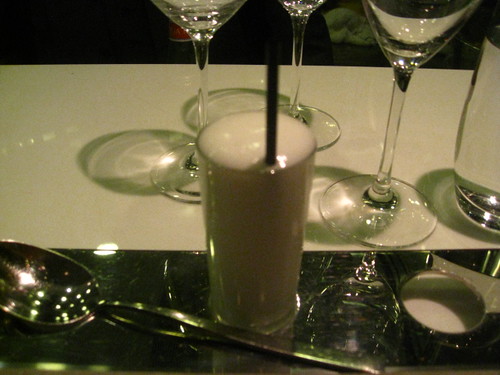
2) Escargot with compressed watermelon, Sichuan vinaigrette with crispy garlic, fried greens – beautifully composed, but again the style is Western with Chinese ingredients.
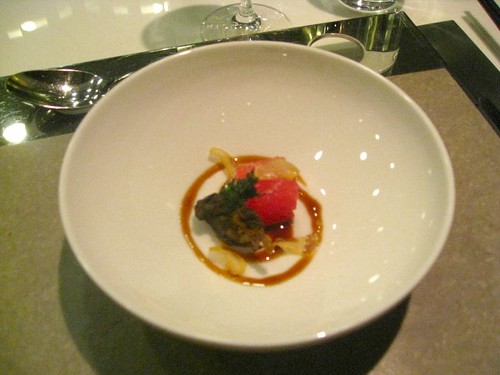
3) Caviar with smoked quail egg and crispy taro – Kaluga caviar from China – reminiscent of Thomas Keller’s Pearls and Oysters – a beautiful dish
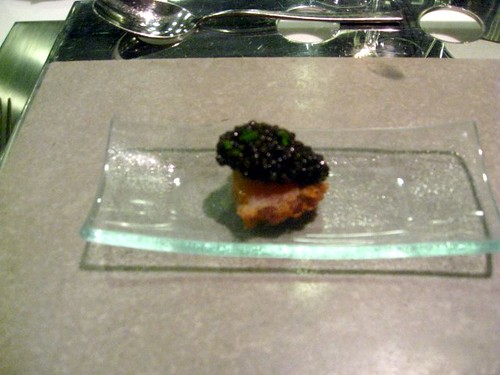
4) Hamachi with black sesame, crispy rose essence ginger – beet juice for ginger, amazing Japanese inspired – for my taste this was the most accomplished dish of the evening.

5) Sea Urchin, ink noodles, chili oil, and “har mi” (Sun-dried shrimp) – very distinctive taste, brave flavors, although perhaps too strong in terms of what came before and after.
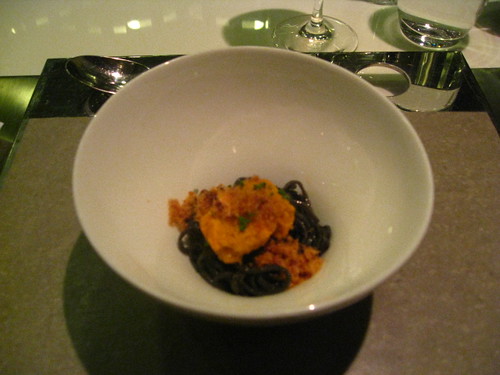
6) Black truffle sandwich, “chian dan chee” – crispy spam and egg sandwich with truffles – one of the best sandwiches I have had with a distinct truffle aroma. Chef Leung is in this menu quite partial to truffles.
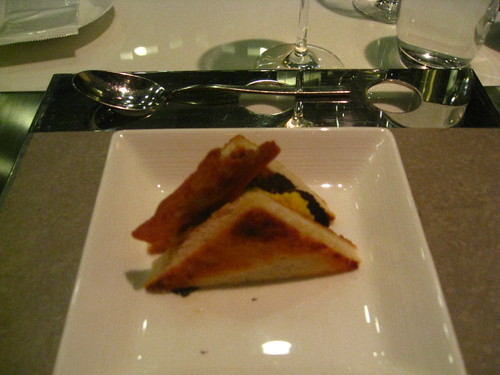
7) Iberico 36 (months cured ham) with morels and porcini, Korean vermicelli, and onion foam – one of the best dishes of the night, a one-bite wonder that effectively combined flavors.
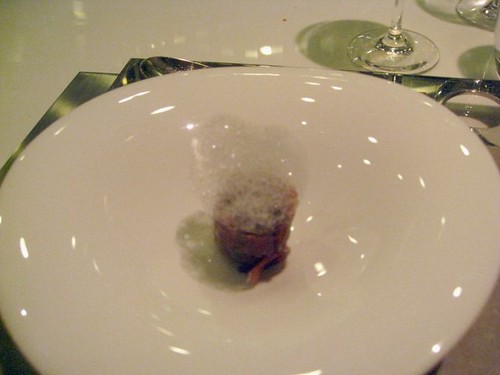
8) Molecular “xiao long bao” – a “dumpling” in a bladder – pork stock with a line of pickled ginger on top, but how Chinese was it really. A cute and pleasant dish, but limited in its appeal. The idea overwhelmed the taste.
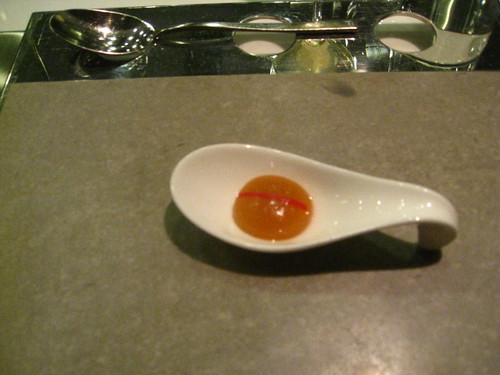
9) Yak and Mac – with black truffle bits – ok, but not so different than mac’n’cheese – Yak cheese, not as good as the yak butter tea that I had from a Yunnan food stall a few days before. But another cute idea.
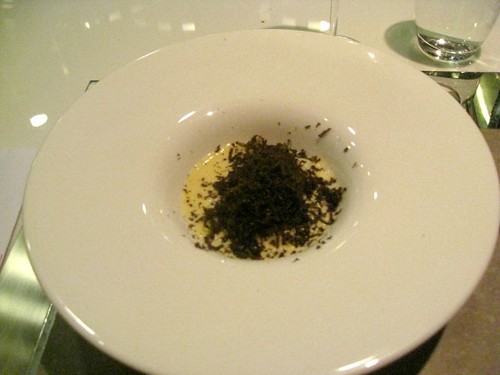
10) Frog Leg “beggar style” – frog thigh stuffed with lotus and shiitake – on small diced vegetables (again, despite the fact that it was based on a traditional Chinese dish, one wonders how Chinese it was? It seemed like a Western appropriation of Chinese cuisine.) Still, the flavors were impressive.
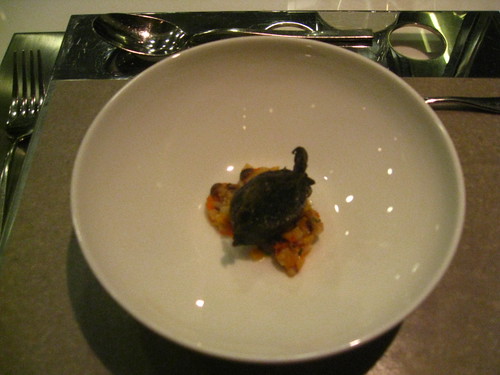
11) Scallop with sesame, kaffir lime, grape aspic, quite beautiful and contemporary in conception
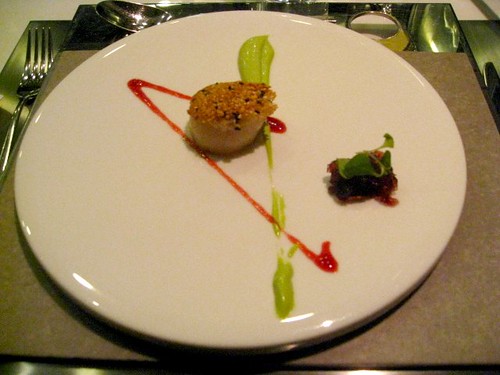
12) Foie Gras with black truffle and turkey congee, looked the same as the yak and mac – a joie d'esprit – a savory donut underneath (no photo – see the photo for Yak and Mac)
13) Halibut with shiitake soil, “yun nam” ham powder, extra virgin olive oil, reminiscent of the “soil” dishes of Wylie Dufresne at WD-50 (no photo)
14) Sweetbreads – oyster sauce (somewhat think but bright) lettuce tempura, artichoke puree – excellent dish; impressively prepared, but it is the oyster sauce than made it Asian.

15) Chalon duck with longon, red rice and preserved kumquat – too gingery to my taste, and one of the least successful dishes of the night.
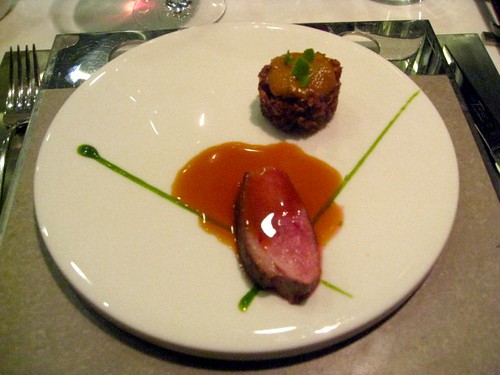
At this point I was served several desserts, which in general were not as inspirational as the savory courses:
16) Almond with sandalwood smoke – a nosegay that is reminiscent of some experiments at Alinea – “Chinese temple”, nice almond ice cream but not revelatory.
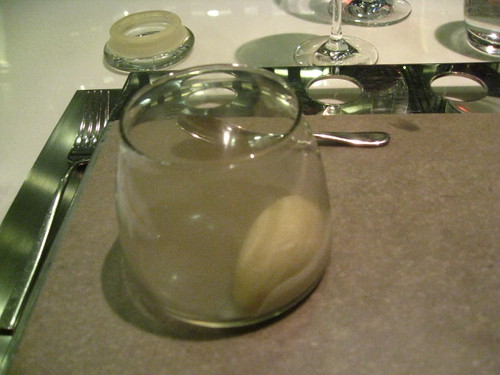
17) Shui Jing Fang – poached caramelized banana and dark chocolate ganache (but served without chocolate since I am caffeine sensitive) mint, rice wine liquor – very nice, and probably better with the ganache.
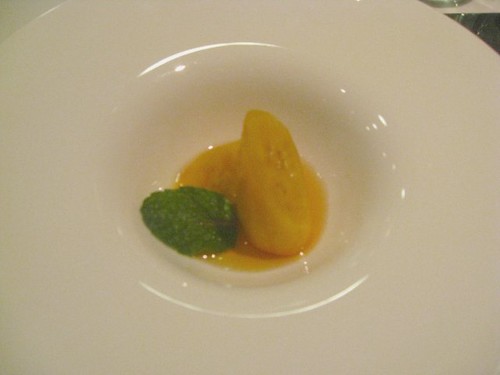
18) Chinese petit fours: kaffir lime macaron, red date marshmallow, salty fudge (no photo)
19) Jasmine kiss – jasmine flowers with liquid nitrogen – another fragrant moment with a tip of the toque to Grant Achatz at Alinea.

I left being fully satisfied by the evening. Bo Innovation provides four-star cuisine, but in its glory raises the question of how Asian molecular cuisine can truly be. Is molecular cuisine always and ever to reflect Western culinary imperialism?
Bo Innovation
Shop 13, 2/f, J Residence
60 Johnston Road (lift on 18 Ship Street)
Wan Chai, Hong Kong
852-2850-8371
http://www.boinnovation.com

No comments:
Post a Comment